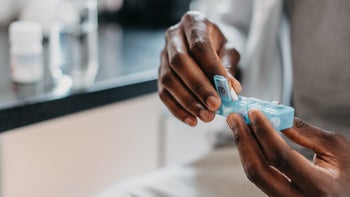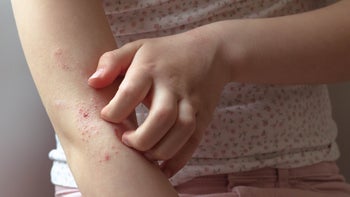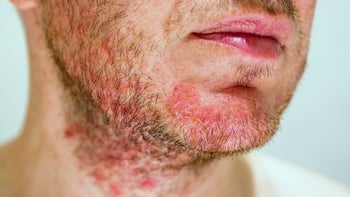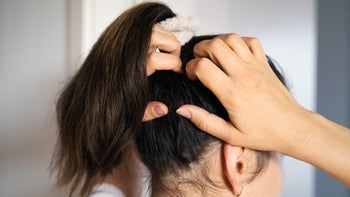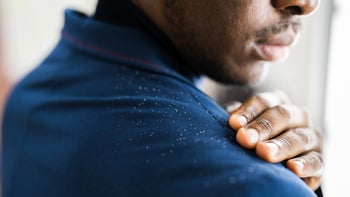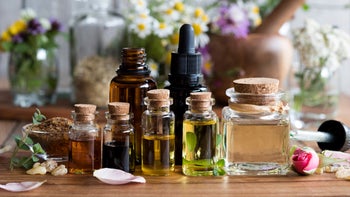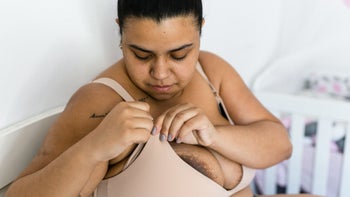
How to Treat Hand Eczema — 5 Tips for Everyday Symptom Relief
Key takeaways:
You can prevent hand eczema by minimizing how often you wash your hands. Using the right hand products can also help.
The best soaps for hand eczema are ones without fragrances, dyes, or irritating chemicals.
More serious hand eczema flares may need prescription creams like topical steroids.
Table of contents

Are your hands always dry and scaly? Do they feel painful, itchy, or sore? If so, you could have hand eczema. And some of your daily habits — like washing dishes — aren’t helping.
But there's good news. Hand eczema is treatable with careful skin care — and, if needed, some medicated creams. Learn more about what causes hand eczema and ways to prevent it.
What is hand eczema?
Hand eczema (hand dermatitis) is a common skin condition. It affects about 1 in 10 Americans. It doesn’t have one single cause. Typically, it happens when someone with a genetic risk for eczema (meaning it runs in their family’s genes) is exposed to a trigger in the environment.
People who have eczema as a child (atopic dermatitis) are more likely to have it as an adult. They might also have related conditions like hay fever and asthma.
Common symptoms of hand and finger eczema are:
Dry, chapped skin (often the first sign)
Patches of irritated skin that are red or dark brown
Scaly and inflamed skin
Itching or burning
Blisters under the skin
Deep, painful cracks
Bleeding or oozing
Scabs, pus, and pain
Common eczema triggers
Many different triggers can cause hand and finger eczema to flare. The most common triggers include:
Cold temperatures (eczema is common in the winter)
Irritation from soap, fragrances, and other irritants
Too much hand washing, typically in jobs like healthcare, cleaning, and catering
Increased stress
Hand sweating, like from wearing latex gloves
What does hand eczema look like (pictures)?
When hand eczema starts, it can be mistaken for dry skin. But there’s a way to tell the difference. If the problem is dry skin, a good moisturizer should be able to fix it. With eczema, there’s inflammation under the dry skin’s surface. That means you’ll likely have other symptoms along with dry skin. And a moisturizer alone may not be enough to get rid of it.
Here are some photos to help you see what hand eczema looks like.
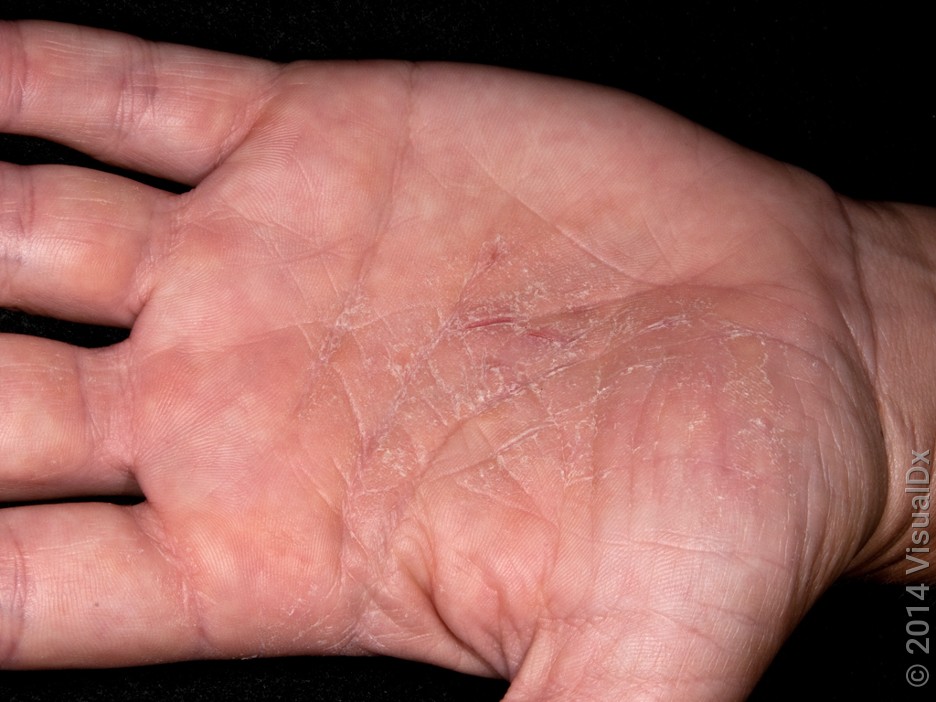

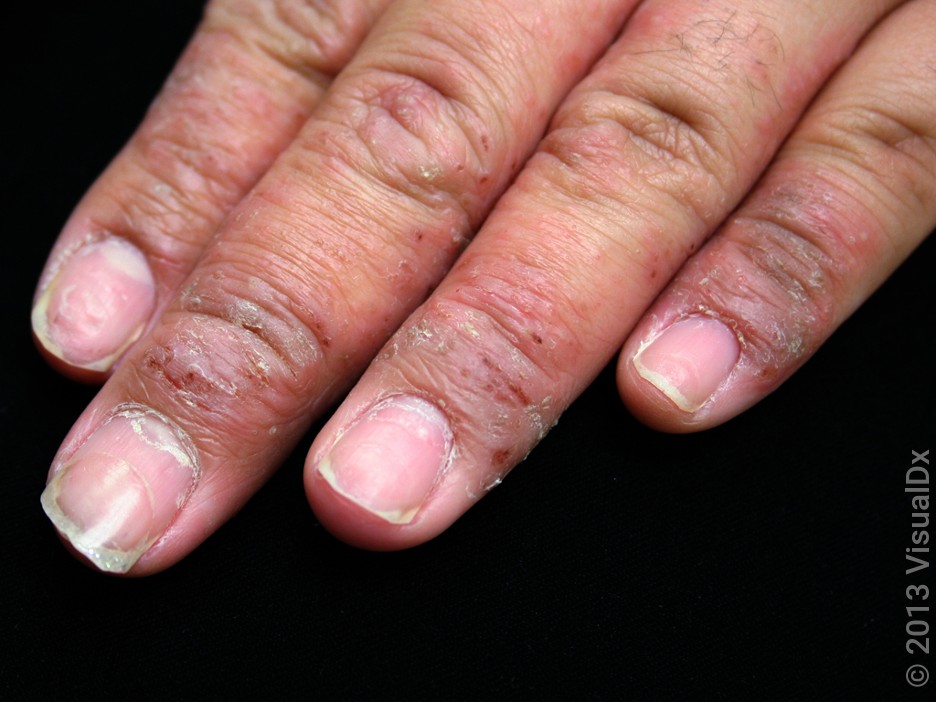

Skin care tips to prevent and soothe hand eczema
To help manage hand eczema, you can add these simple steps to your routine.
1. Choose the right cleanser
Wash your hands with a fragrance-free soap and avoid using hand sanitizer when possible. Hand sanitizers contain ingredients like alcohol and solvents that can be harsh on your skin. Don’t forget to remove rings before washing. This is because soap and water can get trapped underneath and cause irritation. See below for more details on what to look for in a hand soap.
2. Avoid hot water
Washing your hands in hot water doesn’t make them cleaner, but it does damage your skin. So use lukewarm water to wash your hands. If you have eczema on other parts of your body, the same also applies to the temperature of your shower or bath water.
3. Be gentle
Avoid rubbing or scrubbing your skin too vigorously. Like harsh soaps and hot water, this can damage the skin and cause inflammation. Dry your hands by gently patting them with a disposable, soft paper towel or tissue.
4. Moisturize all the time
Apply a moisturizer right after washing your hands, while the skin is still damp. This helps to lock in moisture. Reapply whenever your skin feels dry.
Oil-based lotions and creams work best to improve skin damage. Keep a tube near every sink and carry one in your bag so you don’t forget. Overnight, use petroleum jelly on your hands under cotton gloves. See below for more information on how to choose a good moisturizer for hand eczema.
5. Use gloves to protect your hands
Use vinyl gloves with cotton liners for any housework. This includes dish washing, hand washing clothes, and any time you use antiseptic wipes or cleaning products.
You can also use gloves when shampooing or applying hair products. Wrapping rubber bands around your gloves near the forearm prevents water from getting in. And when outside temperatures drop, wear warm gloves whenever you go outside.
Choosing a good moisturizer for hand eczema
When it comes to hand eczema, moisturizers are not all created equal. The best ones help repair the skin barrier, lock in moisture, and soothe inflamed skin. To get the best results from your moisturizer, look for ones that have some of these ingredients:
Ceramides
Aloe
Glycerin
Lanolin
Petrolatum or vaseline
Mineral oil
Search for moisturizers with the “Seal of Acceptance” from the National Eczema Association.
What type of hand soap is best for people with eczema?
For people with hand eczema, using the right soap is an important part of keeping skin healthy and free of eczema. Many soaps have ingredients that can dry or irritate your skin. They can strip away the skin’s natural oils, which disrupts the protective skin barrier. This leads to skin irritation and eczema.
When choosing soap for eczema-prone skin, try to avoid the following ingredients:
Fragrances
Dyes or colorants
Detergents, like sodium lauryl sulfate
Preservatives, like propylene glycol and formaldehyde
But if you’re overwhelmed by choice, or you’re still not sure, search for products that have the National Eczema Association’s “Seal of Acceptance.”
Best treatment for hand eczema
When it comes to hand eczema, the best strategy is prevention. This means moisturizing your hands frequently and avoiding irritants as often as possible.
For mild hand eczema flares, over-the-counter (OTC) hydrocortisone can help. Use it 2 to 3 times a day for up to 1 week. This may be enough to control symptoms. But if it isn’t, you can try some prescription-only creams and ointments.
Here are some examples of the best prescription medications for hand eczema:
Steroids: Clobetasol, betamethasone, fluocinonide, desoximetasone, or triamcinolone
Calcineurin inhibitors: Pimecrolimus or tacrolimus
Phosphodiesterase 4 (PDE4) inhibitors: Eucrisa (crisaborole)
Janus kinus (JAK) inhibitors: Opzelura (ruxolitinib)
Barrier creams: Hylatopic, Levicyn, Neosalus, Epiceram, or Eletone
In rare cases, medicated creams aren’t enough. You may need to rely on stronger treatments, including:
Steroid pills: Prednisone or methylprednisolone
Light therapy: Narrowband UVB or psoralen with UVA
Immunosuppressives: Cyclosporine, azathioprine, or methotrexate
Biologics: Dupixent (dupilumab)
When should you see a doctor for hand eczema?
If your symptoms are mild, adjusting your skin care practices might be enough. But if you’re struggling to keep on top of your eczema symptoms, you may need professional help.
See your healthcare provider or a dermatologist if you notice any of the following on your skin:
Blisters
Redness
Oozing
Scabbing
Cracking
Pain
The bottom line
Hand eczema is common, especially for people who wash their hands frequently. Too much water and soap can strip away your skin’s natural barrier. This can cause irritation and inflammation. Proper skin care can protect your skin and provide some relief. Use soaps that are free of fragrances and dyes, and moisturize your hands often.
If your symptoms aren’t improving, see your healthcare provider or dermatologist. They can work with you to figure out if prescription medications can help.
Why trust our experts?


References
American Academy of Dermatology Association. (n.d.). Dry, scaly, and painful hands could be hand eczema.
Elsner, P., et al. (2019). Hand eczema: Treatment. Journal of the European Academy of Dermatology & Venereology.
Jensen, D. A., et al. (2017). Quantifying the effects of water temperature, soap volume, lather time, and antimicrobial soap as variables in the removal of escherichia coli ATCC 11229 from hands. Journal of Food Protection.
Kampf, G., et al. (2006). Regular use of a hand cream can attenuate skin dryness and roughness caused by frequent hand washing. BMC Dermatology.
National Eczema Association. (n.d.). 8 skincare ingredients to avoid if you have eczema, according to dermatologists.
National Eczema Association. (n.d.). About the seal of acceptance.
National Eczema Association. (n.d.). Hand eczema.
National Eczema Association. (n.d.). Over-the-counter treatments for eczema.
National Eczema Society. (n.d.). Hand eczema.










